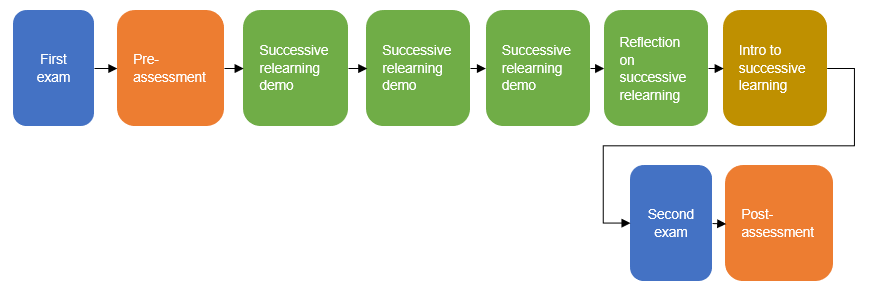How To Convince Students To Use Effective Study Strategies?
By Carolina Kuepper-Tetzel
Students develop preferred approaches to studying when preparing for exams. However, many techniques they rely on are likely to be less effective (e.g., cramming, rereading) than techniques that research has identified as more durable and effective (e.g., spaced practice, retrieval practice). The question is how students can be taught and convinced to use more effective strategies. A recent study by Maurer and Cabay (1) has investigated this question using an in-class intervention and a mix of different methods. They assessed time spent on specific strategies or when students started to study for an exam as well as identified main hurdles for students to use more effective strategies. For the intervention, they demonstrated and taught students about spaced retrieval practice – they call it successive relearning in the paper. The demonstration required students to engage in successive relearning for three sessions plus a reflection session on the application of the strategy in the classroom. Students were asked to repeatedly recall specific course content from memory in a spaced manner. The study was conducted as part of an undergraduate course on the introduction to child development and the overall procedure looked like this:
As mentioned, the authors used a mixed-method approach. One the one hand, they asked students during the pre- and post-assessment to indicate how many minutes they had spent using successive relearning or other learning strategies, when they had started studying for the exam, their confidence in recalling specific content from the course, etc. On the other hand, they had a few open questions allowing to better understand students’ motivation for using or not using taught learning strategies:
Pre-assessment: “Imagine that your course instructor knows about an extremely effective study strategy that dramatically boosts long-term retention and learning of the course material. What would your course instructor need to do to convince you to stop using your existing study strategies and instead use this new study strategy?”
Post-assessment: “If you used successive relearning to study for the last exam, please explain why you chose to do so; if this is the first time you have used it to study for an exam, please explain what convinced you to try it.”
Post-assessment: “If you did not use successive relearning to study for the last exam, please explain why you chose not to do so and what the instructor could have done to convince you to try it.”
As part of the in-class intervention, students learned about the research behind successive relearning and how the demonstration they worked on in the previous sessions was linked to that strategy. They were also told how they could apply the strategy (e.g., using flashcards, making study schedules) and were shown research on other – less effective – strategies.
Image from Pixabay
The results of the study show that there was no difference between pre- and post-assessment on how long students used successive relearning as a strategy (in minutes) or any other learning strategy. There was also no difference in the total number of days they studied. But they found that students tended to start studying a day earlier after having learned about successive relearning and that they were more confident in their acquired knowledge. The more interesting findings, however, were revealed in the open questions.
What should teachers do to convince students to shift their study strategies to more effective ones? The main two themes that were identified here during the pre-assessment were “Explain and Example” and “Evidence or Proof” (there were other themes, but these were the most frequent ones). Students need to know what the strategy is and how they can use it in their learning. Explaining to them how it works, providing demonstrations, and describing how they can start using it on their own seem to be important factors. The second theme identifies evidence as an important aspect. This means that students want to see the research that backs up the recommended strategies and are interested in the proof of effectiveness.
What were the main reasons for adopting successive relearning as a learning strategy? For those students who started using the recommended learning strategy, their main reasons for doing so were the results from the demonstration and awareness of the problem. Thus, the in-class demonstration that required students to use successive relearning as part of the course seem to have convinced students of its effectiveness and students realised that their previous approach was not successful and needed to change.
What were the main reasons for not adopting successive relearning as a learning strategy? The main theme that came up here was “Time Management”. Students reported that they did not manage their time effectively and – consequently – resorted to less-effective strategies (e.g., cramming). This finding is particularly insightful because it shows that it is not a general unwillingness to engage with effective learning strategies on the students’ part, but rather that successive relearning or spaced retrieval practice requires a level of time management skills and following-through plans that students seem to struggle with.
Image from Pixabay
To conclude, the findings of this study help shaping how to teach and guide students through the process of adopting more effective learning strategies. Teaching students about effective learning strategies by showing them the evidence and letting them experience the benefits themselves (e.g., through demonstrations) seems to be worthwhile. However, students would benefit from additional support in developing their time management skills. There are different ways on how teachers can support their students here. I have developed a Time Management and Study Skills resource for my Level 2 Psychology students that can be applied to other contexts as well. Feel free to use and modify it to fit your students’ needs.
Reference
(1) Maurer, T. W., & Cabay, E. (2023). Challenges of Shaping Student Study Strategies for Success: Replication and Extension. Teaching and Learning Inquiry, 11. doi: https://doi.org/10.20343/teachlearninqu.11.18





